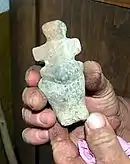Karanovo culture
The Karanovo culture is a Neolithic culture (Karanovo I-III ca. 62nd to 55th centuries BC) named after the Bulgarian village of Karanovo (Караново, Sliven Province 42°30′41″N 25°54′54″E). The culture, which is part of the Danube civilization, is considered the largest and most important of the Azmak River Valley agrarian settlements.[1]
Discovery


Archaeologists discovered the Karanovo settlement in the 1930s when a tell - a settlement mound - was excavated at Karanovo.[1] The hilltop settlement is constituted of 18 buildings, which housed some 100 inhabitants. The site was inhabited more or less continuously from the early 7th to the early 2nd millennia BC. The Karanovo culture served as the foundation of the East Balkan cultural sequence.[2] The layers at Karanovo are employed as a chronological system for Balkans prehistory. This culture had seven major phases: Karanovo I and II, which existed parallel to Starčevo; Karanovo III (Veselinovo); Karanovo IV; Karanovo V (Marica); Karanovo VI (Gumelniţa); and, Karanovo VII, which emerged during the Early Bronze Age.[2]
Characteristics
Some of the main characteristics of the Karanovo culture are the white-painted pottery and dark-painted vessels obtained from the tell.[3] These artifacts were particularly associated with the first and second phases.[4] There is also the Karanovo macroblade technology, which featured semi-steep and steep retouching as well as the use of yellow flint with white spots.[5] This particular technology, which is also known as "Karanovo blade",[6] emerged during the culture's early Neolithic phase.[5] Scholars note its interesting length and width: 100 mm long and between 15 mm and 23 mm wide.[5]
Karanovo II is distinguished from its predecessor due to its influence on the Thracian culture, or the assimilation of its elements into those inherited from Karanovo I.[7] The basic characteristics of this phase continued until Karanovo III and were particularly pronounced in its coarsely made ware such as pitchers, shallow dishes and cylindrical vases (e.g. Kügel).[7]
Literature
- Stefan Hiller, Vassil Nikolov (eds.), Karanovo III. Beiträge zum Neolithikum in Südosteuropa Österreichisch-Bulgarische Ausgrabungen und Forschungen in Karanovo, Band III, Vienna (2000), ISBN 3-901232-19-2.
References
- Danver, Steven L. (2015). Native Peoples of the World: An Encyclopedia of Groups, Cultures and Contemporary Issues. Oxon: Routledge. p. 271. ISBN 9780765682222.
- Gimbutas, Marija; Alseikaitė (1974). The Gods and Goddesses of Old Europe: 7000 to 3500 BC Myths, Legends and Cult Images. Berkeley, CA: University of California Press. p. 248. ISBN 0-520-01995-4.
- Colledge, Sue; Conolly, James (2007). The Origins and Spread of Domestic Plants in Southwest Asia and Europe. Oxon: Routledge. pp. 93. ISBN 9781598749885.
- Colledge, Sue; Conolly, James (2007). The Origins and Spread of Domestic Plants in Southwest Asia and Europe. Walnut Creek, CA: Left Coast Press. pp. 93. ISBN 978-1-59874-988-5.
- Reingruber, Agathe; Tsirtsoni, Zoï; Nedelcheva, Petranka (2017). Going West?: The Dissemination of Neolithic Innovations Between the Bosporus and the Carpathians, Volume 3. Oxon: Routledge. pp. 57, 61. ISBN 9781138714830.
- Reingruber, Agathe; Tsirtsoni, Zoï; Nedelcheva, Petranka (2017). Going West?: The Dissemination of Neolithic Innovations between the Bosporus and the Carpathians. Oxon: Routledge. p. 16. ISBN 978-1-138-71483-0.
- Boardman, John; Edwards, I. E. S.; Hammond, N. G. L.; Sollberger, E. (2003). The Cambridge Ancient History. Cambridge, UK: Cambridge University Press. p. 115. ISBN 0-521-22496-9.
